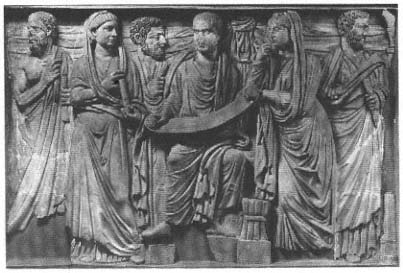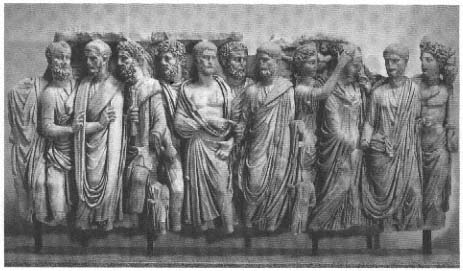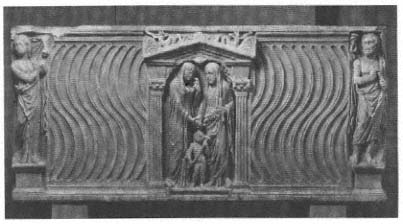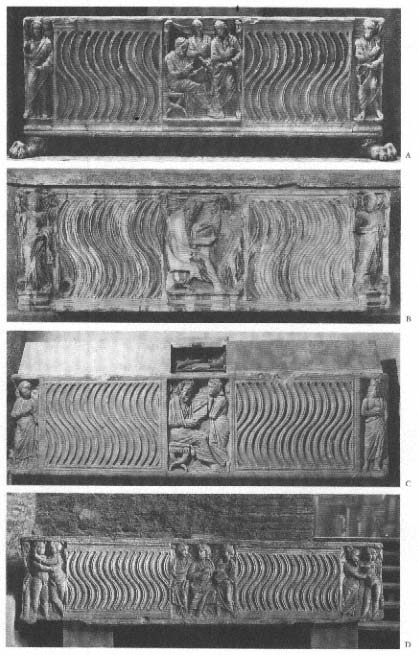Political Office and the Philosophical Life
Despite the familial focus of most of this imagery, some of the more elaborate sarcophagi of the later third century do illustrate the public recognition and auctoritas that come to the educated man who has led his life following the precepts of the philosophers. On a fragment of a huge and splendid sarcophagus in the Vatican that was once wrongly associated with the philosopher Plotinus, the figure of a philosophical layman is "enthroned" frontally before the viewer, not unlike a magistrate presiding at court (fig. 150). He pauses in his reading and looks pensively into the distance. The pile of book rolls at his feet alludes to his devotion to his intellectual pursuits. Two women belonging to his

Fig. 150
Fragment of a lavish sarcophagus ca. A.D. 280, showing an amateur philosopher
surrounded by Muses and philosophers. Rome, Vatican Museums.
family—both have portrait features and wear hairstyles of the period—stand beside him and look on admiringly.
Like Peregrinus, the deceased was surrounded by a group of philosophers, though the fragment preserves only three. But unlike Peregrinus' itinerant Cynics, these belong to a more presentable breed. In addition, the sculptor has taken pains to differentiate their outward appearances. Thus one wears a long undergarment, while a second, whose balding head recalls Socrates, wears only a mantle, and the third, who is distinguished from his well-tended colleagues by his wild hair and beard, nevertheless wears his mantle properly draped. It would seem that they are meant to be representatives of different philosophical schools, and all served as advisers to the deceased. But the one with wild hair, who stands beside and addresses him, seems the most trusted, probably his closest confidant. The arrangement of the figures makes clear the hierarchy within the ranks of the counselors. An encyclopedic education is the prerequisite for the philosophical life, but
in the end what matters most is adherence to a moral standard, which can be achieved only through constant spiritual exercise and the help of a role model whose own life admits no compromise.
Intellectual superiority is presented here as the highest form of auctoritas, expressed in the frontal image borrowed from Imperial state monuments. And yet this is once again not a professional intellectual, but rather, like Peregrinus, a layman or, as Marrou says, an "amateur." The style of his shoes (calcei ) may suggest his identity as a member of the equestrian order.[15] Although we have thus far considered only sarcophagi whose imagery is confined to the private and domestic sphere, there are other examples from the time of the emperor Gallienus (A.D. 260–268) and later that make clear the direct connection between intellectual pursuits and political office. The prestige of learning acquired through rigorous philosophical training had now apparently grown to the point where even men of consular rank considered this an integral element of their identity and not merely a convenient status symbol. In the time of Marcus Aurelius, by contrast, these same Roman aristocrats had used traditional imagery to celebrate their virtus and their qualities of military leadership, especially on the battle or "Feldherrn" sarcophagi.[16] Yet this is the same period in which we saw evidence for the high valuation of learning in the Zeitgesicht and the fashion for long beards.
The so-called Brother Sarcophagus in Naples presents four versions of the same deceased individual, probably a Roman senator, in different outfits and poses, in contiguous scenes (fig. 151).[17] That it is the same man is clear because his portrait features remain the same. The whole image is thus a kind of "gallery" of the type sometimes partially preserved in the form of busts or statues and attested in written sources for the emperors themselves.[18] So, for example, a painting in the palace of the Quinctilii depicted the emperor Tacitus (A.D. 275–276) in five variations, as togatus, chlamydatus, armatus, palliatus, and venatorio habitu (Hist. Aug., Vopisc. Tac. 16)—that is, in a toga, in a military "traveling outfit," in a cuirass, in the Greek mantle, and in hunting costume. The picture sounds like the visualization of one of those particularly verbose honorific inscriptions. Similarly, the Naples sar-

Fig. 151
So-called Brother Sarcophagus, showing the deceased in various
"roles." After A.D. 260. Naples, Museo Nazionale.
cophagus celebrates in turn each of the most important virtues or spheres of activity of a senator or other high official. At the left we see him at the acme of his political career, assuming office, while at the far right his marriage is shown. Thus his exemplary private life is presented as the counterpart to his political career. In the center, however, he is shown once in the guise of the ascetic Greek philosopher, wearing only the himation, and once as a Roman wearing a toga. The two seem as if in conversation, but this of course is not to be taken literally. Rather, the pairing expresses the inextricably linked dual identity of the Roman aristocrat, comprised, in equal measure, of the precepts of philosophy and the traditional values of the mores maiorum —however the boundary between these two may have been defined. In his guise "Roman," the honorand wears a simple toga. The little attendant next to him alludes to that most important of the old Roman virtues, religious piety.
The Brother Sarcophagus is far from unique. There are other,

Fig. 152
Sarcophagus of married couple. In the middle they share in a sacrifice; in
the corners, he is shown as a philosopher, she as a Muse. Second half
of the third century A.D. Munich, Glyptothek.
less extravagant sarcophagi that show the deceased both in ail old-fashioned toga and in the pallium, or as a public official wearing the toga contabulata, along with his philosopher-advisers. A good example is an unusually large strigilated sarcophagus in the Glyptothek in Munich, Severan in date (fig. 152).[19] Here again a married couple appears in two different guises. The scene in the middle celebrates their marital concordia, while the figures in the corners allude to literary, philosophical, and musical education. The husband gestures toward his book roll as if to make a point; his wife, in the pose of Urania, points to a globe (sphaira ) that was originally held in her left hand. As on other sarcophagi of this type, both individuals are elevated on pedestals. In this way a connotation of "public honors" is evoked to enhance the praise of the dead.
These are important monuments in the history of Roman intellectual imagery. The pallium now enjoys a status equal to that of the toga in the catalogue of virtues prescribed for the Roman aristocracy and even the emperor. We may recall that among the five images of the
emperor Tacitus was one wearing this type of Greek mantle (palliatus ). What was once a leisure pastime with dubious moral connotations has now become an indispensable prerequisite for the man of public affairs. As is well known, in the Late Empire, a good education, including philosophy, became an important criterion in the recruiting of high officials in the imperial bureaucracy and, just as at one time the withdrawal into a world of intellectual otium, it was also a kind of status symbol.[20] The extraordinary value for the historian of the visual evidence lies in demonstrating to what extent these criteria were, by the second half of the third century, firmly established within the value system of urban Roman society.
The number of splendid sarcophagi of high artistic achievement, of the type we have been looking at, is of course relatively small. But at the same time a large class of simpler, so-called strigilated sarcophagi gives evidence of how widespread the same kind of self-image had become among broad strata of the prosperous "middle class" in the city of Rome, those who could afford a marble sarcophagus in the first place (fig. 153). Even among those of modest artistic pretensions, the majority at least allude to the intellectual pursuits of the deceased in the form of a book roll. Generally the front side of the sarcophagus is decorated with three small scenes in relief, in the middle and at the ends, the remainder filled with the ripple pattern. The scenes repeat the visual program of the larger sarcophagi, only reduced to a set of shorthand slogans. The same is true of the widespread integration of these scenes amid other kinds of imagery, in particular of shepherds in a bucolic setting. Often the deceased couple stands or sits opposite one another at the two corners in the traditional roles of philosopher and Muse (or, later on, as praying figures: orans ), as on the fine sarcophagus in Munich (fig. 152). The husband almost always wears the more ascetic kind of philosopher's mantle, without an undergarment. He is no longer afraid of identifying himself fully with his role model. A striking motif in the middle panel of some examples is of a professional philosopher, either reading alongside a Muse or engaged in conversation with a colleague. The long hair of some of these men recalls the

Fig. 153
Four modest strigilated sarcophagi showing the deceased either in the guise
of a philosopher or as a Muse. Second half of the third century A.D. a) Florence,
formerly on the Ponte Vecchio. b) Pisa, Campo Santo. c) Porto Torres (Sardinia).
d) Rome, Museodelle Terme. (Wegner 1966, nos. 31, 79, 81, 127.)
Charismatic philosophers, the "holy men" whom we heard about in the previous chapter and will shortly encounter again in our discussion of the image of Christ. In abbreviated form they carry the same message as the circle of ascetic philosophers around Peregrinus or the philosophical friends of "Plotinus," only the feeling of reverence for philosophical instruction is even more clearly articulated.[21]
There are only two themes that can rival the popularity of the Muses and intellectual imagery on sarcophagi of the later third century: hunting, which was the traditional symbol of strength, courage, and valor, and the bucolic shepherds. But it is also significant that the "philosophers" now often take over the pastoral setting, and on one of the more magnificent sarcophagi the tried and true symbol of virtus is actually relegated to the back side, while the front is given over to the philosophers.[22]